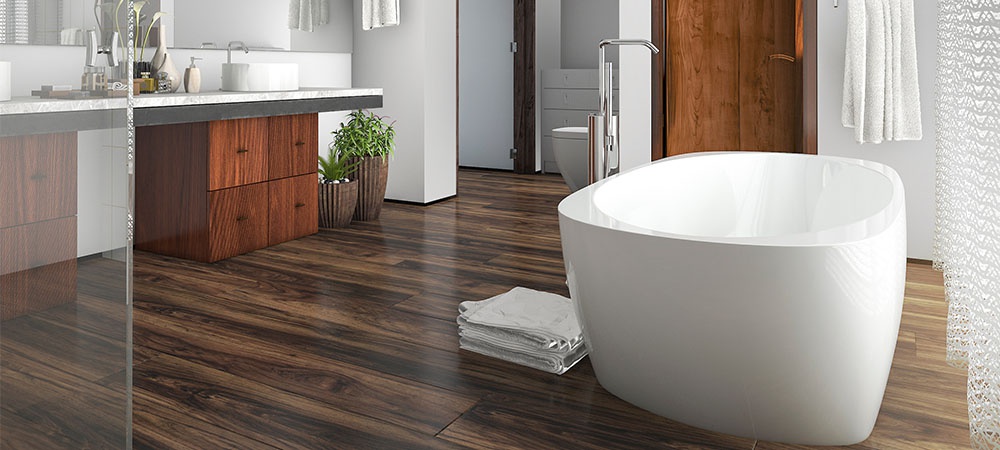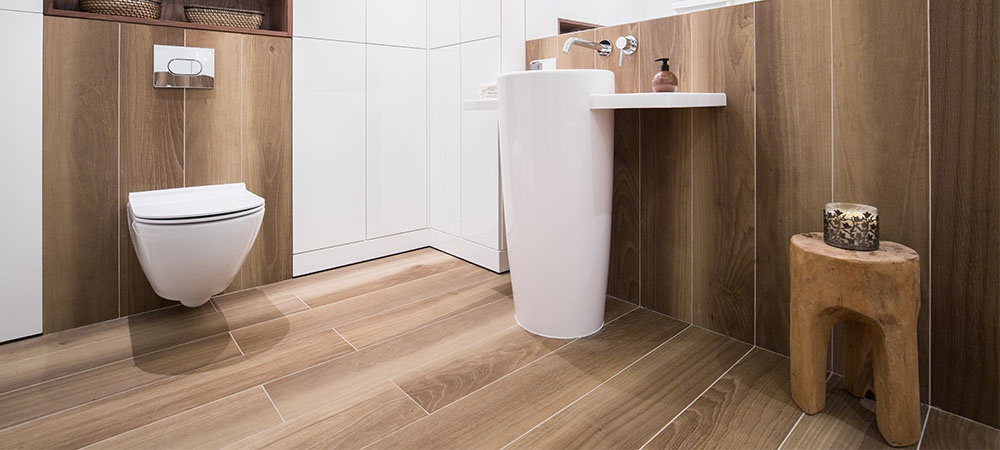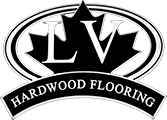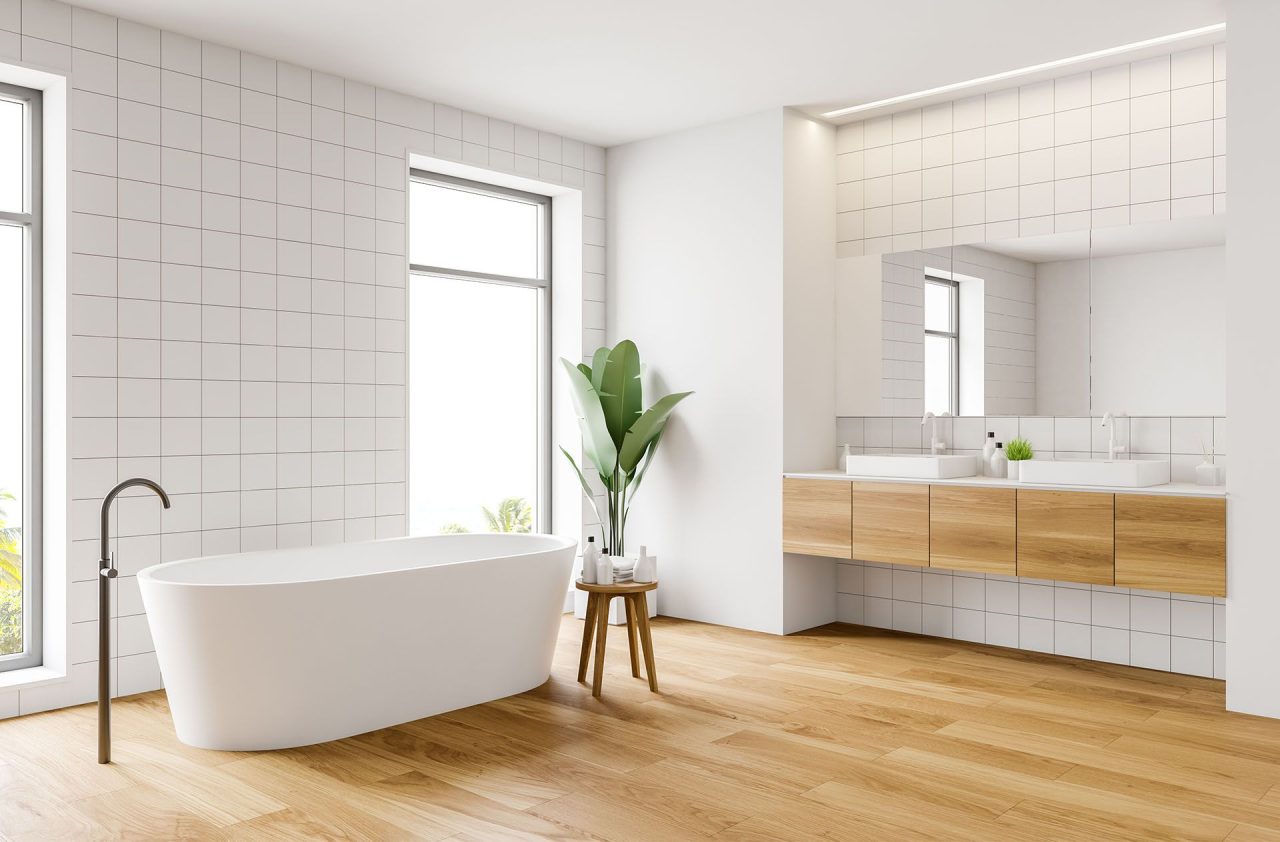The comparison between regular wood flooring and engineered wood flooring isn’t taking a backseat anytime soon. The former argues to be antique and simple, while the latter is said to be fashionable.
The truth is that engineered floors improve any space. But the question is whether this quality extends to the most private room in your house — can you install engineered wood flooring in the bathroom?
The bathroom is one of the most humid places in the house, alongside kitchens and basements. So we understand your worries about not wanting water to damage your expensive new wooden floors. That’s why we’re here to let you know if engineered wood flooring is one of the viable options for your bathroom.
Here, we’ll explain what engineered wood flooring is. Then, we’ll let you know if you should consider installing it in your new, improved bathroom.
Let’s get into it.
What Is Engineered Wood Flooring, and is it Good for Your Bathroom?
Unlike traditional wood flooring, engineered wood flooring construction is usually without the need for glue or nails. Instead, it relies on binding to hold individual pieces of wood together. Therefore, “layering” in produced boards.
Engineered wood is a regularly desired choice because of two factors: utility and aesthetics. These two factors are often at the helm of what distinguishes this material from the others. Engineered wood flooring can be identified from other options by its special characteristics.
Engineered hardwood consists primarily of a wood veneer bonded to a synthetic core. This innovative method of construction produces flooring that mimics the look of traditional wood but is much more sturdy and long-lasting.
Artificial plywood or particle board is crucial in creating the core of these engineered woods. Some producers use high-density fiberboards. Canada’s selection of engineered hardwood flooring includes options with varying degrees of durability.
The production of engineered wood involves a higher level of expertise and sophistication than conventional solid wood boards. But it also implies there are further advantages.
For instance, it’s easier to keep engineered hardwood in great condition over its lifespan. Exceptional in function and design, engineered wood flooring is the product of extensive study and creativity. An additional benefit of engineered wood is its increased stability.
The versatility and low cost of engineered wood contribute to its widespread use. Due to these advantages, it has quickly replaced solid hardwood floors as the industry standard.
Is Engineered Wood Flooring Ideal in the Bathroom?
Regarding the bathroom, the only type of wood flooring recommended by experts is engineered wood. In other words, only engineered wood flooring can easily withstand bathroom humidity. Other species of wood and wood-installation technologies may not be acceptable for bathroom settings.
Among the numerous benefits of engineered hardwood is that it’s impervious to water. This feature is due to the expert engineering incorporating synthetic and natural wood materials.
How About Hardwood For Bathrooms?
Speaking of regular hardwood in relation to moisture, they’re not a good combination. This discord is because prolonged exposure to high moisture and humidity can accelerate the deterioration of some wood species.
In fact, these factors can be damaging to the structural integrity of solid wood. Even the smallest empty gaps on wood surfaces can absorb moisture.
This drawback will result in a gradual size reduction. It’s a hit to the wood flooring’s aesthetic value and long-term stability. It’ll weaken and deteriorate faster once constantly exposed to dampness/water.
On the contrary, engineered wood has top marks where moisture management is concerned. Engineered wood is given special treatment from the factory to ensure its resilience to changes in humidity and temperature. To put it bluntly, that’s a massive plus for bathroom installation and convenience.
Once Again: Is Using Engineered Wood in The Bathroom Fine?
After all said above, the response is unquestionably affirmative. An engineered wood floor is your best bet to have a bathroom’s best possible wood surface.
But you need to buy quality engineered wood flooring and work with a good installer. These two factors will ensure your floor looks like it should for a bathroom layout.
Features of Engineered Wood that Make it Ideal for the Bathroom
Will engineered wood flooring last in the bathroom? Now that’s dependent on the quality of engineered wood flooring you get.
Engineered wood floors in the market can’t be guaranteed to meet the same standards for longevity and value as other goods. But they all have a common set of essential characteristics. This possible variation results from little differences in production methods.
The following are some of the universal characteristics of premium engineered hardwood floors:
Strong Center/Core
For layers, the range to look out for is roughly 3-13 mm. Increasing the number of ply layers results in a thicker plank with a more stable center.
There is a direct relationship between the depth of your wallet and the price tag. With the help of your contractor or supplier, you can compare the costs of several engineered wood solutions.
The main component of this sort of flooring is the core. Compared to solid hardwood, this engineered wood flooring characteristic makes it perfect in the bathroom.
Wear Layer
The top veneer or wear layer is another name for this layer. When the engineered wood wear layer has a proper build, it looks and feels just like solid wood. Nonetheless, engineered wood has a wear layer of only around 4mm, while solid hardwood has a wear layer of 6mm to 7mm.
Engineered wood floors can last for decades despite their thinner wear layer. The compensation of their thin layer is in the thickness of their core. These woods can last on your floor for well over 40 years with minimal care.
Layers part
Find out how many layers are in the flooring planks by inquiring with your supplier. Commonly, components will have a veneer layer and many overlays — the greater the number of layers, the better the timber.
Thickness of a Veneer
A wood floor’s longevity is proportional to the thickness of its veneer. The thickness makes it exceptionally resistant to stresses and loads.
The starting thickness is 2 millimetres. However, if you’re looking to move beyond “normal” materials and into stronger varieties, you’ll want to aim for a thickness of 3mm or more.
Related Article: Laminate Flooring Ideas for a Bathroom

Advantages of Installing Engineered Wood Flooring in Your Bathroom
As the hardwood flooring industry keeps growing fast, different questions come from various sectors. For example, a question is common among potential installers of engineered hardwood floors in bathrooms. And the question is whether the flooring is worth the buy.
The incredible advantages of engineered hardwood flooring prove that the investment is worthwhile. Here, we’ll especially let you see why installing engineered wood in the bathroom is a fantastic idea.
1. There’s Less of a Chance Of Damage From Water Seeping Through and Warping Engineered Wood Floors
Floors made of engineered wood were initially for installation on concrete. And also for areas with increased moisture levels.
There’s a risk of warping over time with solid wood flooring and susceptibility to damage from moisture. On the other hand, moisture has little effect on engineered wood flooring compared to solid wood flooring. This perk is due to the former’s high-end construction.
Water resistance has made engineered wood flooring a popular choice for many construction projects, particularly in damp environments like bathrooms and basements.
2. Engineered Wood Flooring Allows Radiant Heat On The Bathroom Floor
Engineered wood flooring is often appropriate for use with underfloor heating. And this feature is a definite plus. Underfloor heating creates a cozy and comforting atmosphere when installed in a bathroom.
3. Passes For Real Wood
One of the best features of modern engineered wood flooring is its realistic appearance. After first being looked down upon as a second-rate substitute for real wood, engineered wood has since proven its worth, even to its most vocal detractors.
Even the most skeptical person can be convinced by a high-quality engineered wood floor that it is, or at least could be, solid wood.
Engineered wood flooring in the bathroom doesn’t undergo the same degree of expansion and contraction as solid wood. As a result, this edge is perhaps one of its most significant benefits over solid wood, besides its superb appearance.
As a result of its superior design, engineered wood flooring is less susceptible to the expansion and contraction that can damage solid wood. This feature makes it suitable for use in areas where solid wood would be a liability.
Top-quality engineered wood floors won’t disappoint in the face of extreme moisture and temperature changes, such as those in bathrooms.
4. High Resistance To Wear And Tear
Many layers of plywood are first bonded with glue to create engineered wood flooring. Afterwards, there’s a covering with a lamella or top layer of solid wood. All these layers allow engineered wood flooring to withstand severe use in rooms like the bathroom.
5. Sandable
That an engineered flooring is in the bathroom doesn’t make it unsandable. In fact, engineered wood flooring can be sanded multiple times throughout its lifetime.
However, the number of times it’s sandable will depend on the lamella’s or top layer’s thickness. When your bathroom floor seems worn, simply make it look new by sanding.
As a bonus, this method will function greatly in removing any discoloration or markings from your bathroom flooring.
6. Engineered Flooring is Refinishable
After sanding your engineered wood floor, refinish it to restore its protective coating and revitalize its appearance. Essentially, you can alter your engineered wood floor’s appearance at any time by sanding it and applying new paint or finish.
7. Engineered Wood Flooring is Available In an Array of Grades, Species, And Finishes
The school of thought arguing for solid wood flooring may say it comes in various qualities and species. But the same also goes for engineered wood flooring. Its lamellas or top layers are readily available in the same variety of species and quality as those of solid wood flooring.
The above allows you to realize your desired aesthetics while selecting the optimal finish for your needs. Also, because there are varying quality levels of wood available, you can tailor your decision to your spending limits.
You can choose between an affordable version that’s durable and lacquered or an upscale alternative that’s classic and oiled. Regardless, the engineered wood flooring will look amazing in your bathroom.
8. Perfect for Longer Boards
As a result of the manufacturing process, an especially large tree is the way forward for producing a wide solid wood board.
But engineered wood flooring doesn’t operate the same narrative. Plywood (engineered wood comes from it) allows for far broader boards than would be possible with solid wood flooring. And this possibility comes without increasing the price significantly.
Engineered wood flooring allows you to use two- or three-strip engineered wood in your bathroom. You’ll have fewer seam sights across the floor, and installation happens in a fraction of the usual time.
9. Available in a Chevron Pattern Or A Parquet Style
You won’t only have engineered wood flooring in the bathroom. You’ll also be able to install them in exotic styles like parquet and chevron patterns.
If you want a detailed parquet or chevron floor with no stress, consider purchasing engineered boards that have already been finished in the desired style.
10. Quick Lay and Installation
Due to its versatility and ease of installation, engineered wood flooring is easy to lay in your bathroom. If, for example, you’re interested in attempting such a DIY project for the first time. You can use a click system that makes installing engineered wood flooring much more effortless.
11. It Won’t Put A Dent In Your Wallet
Finally, engineered wood flooring has the excellent benefit of appearing expensive without actually being such. So your bathroom will look all luxurious with engineered wood flooring without costing you so much.

How Much Do Engineered Hardwood Floors Typically Cost?
Engineered hardwood floors in Canada typically cost about $7 per square foot. But naturally, this isn’t the only factor considered when setting prices for engineered hardwood.
In addition to the purchase price, you may also be responsible for paying for the installation cost. Nail-down installation can cost as much as $2.50 per square foot. Costs range from $8 to $12 per square foot if higher-quality wood is selected.
Cleaning Tips For Your Bathroom’s Engineered Wood Flooring
Engineered wood floors are low maintenance if you take care of them. Simply sweeping or vacuuming wood floors daily and taking care of them will keep them looking great for years to come. In addition, it’ll prolong the life of your flooring.
But there’ll be times when a deep clean is required. The most advisable methods for cleaning engineered wood flooring in the bathroom are as follows:
Clean with Damp Mop
A mop is as good for bathroom engineered wood flooring as a broom for bare floors. Leave a little moisture in the mop. But you shouldn’t soak it with water.
Lamella is natural wood that can distort when wet. Therefore engineered wood floors are more water-resistant than solid wood floors, but you still need to be cautious with them.
Non-abrasive microfiber mops are effective on engineered wood floors. Use either disposable or washable microfiber pads on your mop.
Invest in a Good Cleaner
Many commercial floor cleaners are safe for engineered wood flooring in bathrooms. Furthermore, you should test the cleaner on a small floor area to ensure it does not damage the finish.
Please adhere to the cleaner’s guidelines. If you want your wood floors to always look like new, don’t ignore this cleaning precaution.
Rinse
Once you finish mopping your floors with the cleanser, rinse them with clean water. First, examine the floor for any signs of cleaner residue, which may stand out more against a glossy surface. Then, use clean water and a fresh mop to remove any remaining residue.
Deep Cleaning
There’s no way around the need for a more thorough cleaning. The floors will get grimy if you walk around on them.
Regular sweeping and mopping may prevent dirt from being ingrained in your flooring. But there’ll be times when a more thorough cleaning is necessary. If you require a more thorough cleaning, experts can recommend a product that’ll do the job.
The same technique for mopping up less intense spills should also function here. Simply use the stronger cleaner once, and then follow up with a clean mop.
Our recommendation for how often you should perform a thorough cleaning will vary with the type of wood you select for the top layer. However, an appropriate interval is every 4–6 weeks.
Related Article: What Is The Cost of Installing Engineered Hardwood Floors?

Summary
Should I use engineered wood flooring in the bathroom? Absolutely! You can even install it yourself. And it won’t have you breaking the bank.
The only remaining query is choosing the best engineered hardwood design for your bathroom. And LV Flooring can answer that need by providing top-quality engineered hardwood planks in different stylish designs.
Look through our online store or call (416) 665-5645 to discuss alternative flooring options today.


